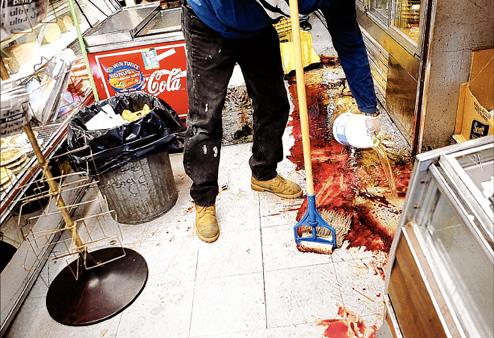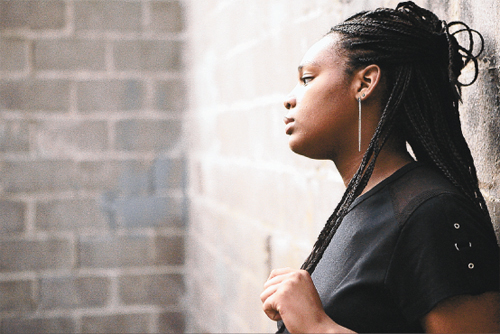Shots that echo forever
The Star-Ledger, May 15, 2005
Long after the physical scars have faded, the mental anguish inflicted by gun violence continues to take a heavy toll

When a drive-by gunman’s bullet ripped into 12-year-old Bianca Webb’s chest 18 months ago, a first-rate public health system got her to the hospital, stitched her wounds and nursed her back to health.
But after thousands of dollars in medical care, Bianca still is not completely healed. She has a .40- caliber slug lodged 4 inches from her heart. She worries about lead poisoning her blood. She can’t play sports. She’s behind in school and flashbacks keep her up at night.
“It’s changed my life in lots of bad ways,” the soft-spoken Newark seventh-grader said. “I can’t do anything. I still ask myself, ‘Why me?’”
Bianca is among the hundreds of people who get shot every year in the Newark area.
Most don’t die.
In Newark, the state’s largest city, 364 people were shot in 2004. Sixty-eight died. The others tried to return to their lives, often with the help of canes, wheelchairs or colostomy bags.
That alone is costly.
At University Hospital, which treats most shooting victims in Essex County, officials said it cost about $20 million to treat 270 people for gunshot wounds in fiscal year 2004 - a figure that does not include those who were treated and released. Two dozen of the most seriously wounded ended up at Kessler Institute for Rehabilitation in West Orange with spinal cord injuries, according to Steven Kirshblum, the institute’s associate medical director. The cost for their rehabilitation ranged from $90,000 to $300,000 each.
Most of those bills are covered by taxpayers. At University Hospital and Kessler, about 90 percent of gunshot patients lack private heath insurance, leaving Medicaid to cover their treatment.
But the “greatest cost is not financial or physical - it’s mental,” said the Rev. Thomas Ellis, head of a Newark anti-violence organization, who himself was shot during a 1997 armed robbery in Atlanta. “We need to educate the public about this, because people don’t understand what’s happening.”
What’s happening is this: a growing list of thousands - victims and countless other relatives, witnesses and children - is suffering from the incalculable wounds of gun violence.
These are some of their stories.

HIDDEN WOUNDS RUN DEEP
When the doctors finish and the police move on, the broken survivors are left in obscurity to deal with wounds that can’t be seen, counted or paid for. This emotional trauma can last a lifetime.
“The implications go way beyond the physical suffering,” Kirshblum said. “Most injuries are freaks of nature, unfortunate events. But gun violence is something that is done specifically to hurt the person, if not to kill them. And that sticks with them forever.”
Therese S. Richmond, a nurse who studies gun violence at the University of Pennsylvania’s Firearm and Injury Center, tracked dozens of victims for years after they were released from the trauma ward. She found they rarely live happily ever after.
“They say, ‘You saved my life but you did not heal me,’” Richmond said.
Rodney Mason knows that anguish. He was shot on Oct. 9, 1995 by a man who had threatened to kill him for seeing his girlfriend. Mason hadn’t taken him seriously.
Mason, 37, still remembers the red Honda CRX bearing down on him that night, and he remembers falling in a shower of bullets. One 9 mm slug stuck in his spine, paralyzing him from the waist down. He spent three months in the hospital, another three months at Kessler, and he continued rehabilitation for a year as an outpatient before coming home for good in a wheelchair. The cost, about $300,000, was covered by Medicaid. Now he lives on payments from the Victims of Crime Compensation Board and $7,560 a year in public disability checks.
“There would be some closure if I woke every day and was able to stand up,” he said. “But waking up every day and getting into a wheelchair, there will never be closure for me.”
Mason spends most days in his tiny apartment, lifting weights, watching television and playing video games. On nice days, he wheels himself to the sidewalk to watch the bustle of the street. He sits there, wondering what it would be like if he’d done things differently.
A standout pitcher on Newark’s Shabazz High School baseball team in the mid-1980s, Mason chose not to take his talents to college. Instead, he ran the streets and dabbled in drug dealing. He spent five months in state prison on drug charges in 1991. He says he was working as a full-time superintendent at an apartment building when he was shot.
His assailant, meanwhile, did eight years in prison and has moved back to the city. Mason doesn’t even want to take the bus for fear of running into the man.
“I’d be lying if I said I’m not still traumatized,” Mason said.
Mason dipped into a long depression after the shooting and was unwilling to leave home, said childhood friend Obalaji Baraka.
“He had to overcome his fear of life,” Baraka said. “He didn’t want to live anymore.”
Mason since has emerged from his withdrawal, Baraka said. “He’s come a long way, but he’s still not the same person. You can see it in his eyes. He doesn’t have the fire that he used to.”

FEAR OF RETALIATION
Victims fear their attackers long after being shot. Often, a victim knows the person who shot them. Usually, the attacker doesn’t get caught.
In Newark, for example, there were 437 non-fatal gun assaults, including incidents in which people were shot at but not hit or had a gun pointed at them. There have been arrests in 195 of those incidents. In neighboring Irvington, there were arrests in 15 of the 109 non-fatal gun assaults.
“This adds a much greater burden emotionally onto the person,” Kirshblum said. “To see the person re-accepted into society is very difficult.”
Police say shootings are tough to solve because surviving victims often are too scared or bent on revenge to cooperate, and witnesses don’t want to be seen as snitches.
Newark Police Director Anthony Ambrose said many people arrested for shootings are released on bail. “This causes fear in the community that there will be a reoccurrence or retaliatory attack,” he said.
In most cases, police say, shootings are the work of a relatively small subset of criminals targeting each other not just over drugs and gang rivalries, but more petty things, like a woman’s affections.
In this environment, it isn’t only the victims who suffer, experts say. Families struggle. Witnesses are traumatized. Children develop behavioral and emotional problems.
“A lot of shootings are targeted attacks by drug dealers and gang members, but they also disrupt neighborhood life,” said Michael Wagers, director of the Police Institute at Rutgers-Newark, a criminal-justice research group. “It creates a feeling of fear in the community. And you have a younger generation growing up who witness these things.”
In response, local and state police have teamed with the Police Institute, community groups and clergy to try to cut gun attacks and address the myriad ways gun violence wreaks havoc on relatives, neighbors and children. Modeled on a program in Chicago that helped reduce shootings in several of the city’s toughest neighborhoods, Operation CeaseFire started last week in a bullet-riddled area along the Newark and Irvington border.
“If we’re going to prevent shootings, we have to attack the culture of violence at its earliest stages,” said Stanford Brown, director of The Bridge, a family service agency that is part of the project. “That means targeting not just the bad guys, but reaching out to families, the neighborhood, the kids.”
A KIDS’-EYE VIEW
The shootings on Lamont Brooks’ street in Newark’s Central Ward have him too scared to stay home alone or sleep in his bed. Last July, he was caught in the middle of a gun battle while riding his bike. He wasn’t hit, but a stray bullet injured a woman up the block.
“I’m scared for my mother, my big sister and my little brother,” the skinny sixth-grader said.
Lately, Lamont has been suffering from anxiety attacks and getting into fights at school. So his mother, Cherisse Moore, takes him for after-school counseling five days a week at the University of Medicine and Dentistry of New Jersey.
The program, run by UMDNJ’s behavioral healthcare unit, helps children who have been victims of or have witnessed shootings and other kinds of violence. Susan Esquilin, the unit’s clinician administrator for children’s services, said these kids often suffer from symptoms similar to post traumatic stress disorder, including chronic anxiety and sleeping problems. They also tend to consider gun violence normal behavior and to imitate the people involved in it.
“From the kids’ perspective, these look like powerful people,” Esquilin said.
Freddy Ruiz was one of those kids.
Growing up in Newark’s Baxter Terrace public housing complex, Ruiz grew so accustomed to gun violence that he thought of it as the routine way to settle a dispute.
“It was, ‘Oh well, that’s another person dead,’” Ruiz, 30, said. “You grow up with this armor around you, and violence doesn’t affect you. You’re numb to it.”
That changed in October 2003, when Ruiz’s mother, a respected neighborhood fixture, was killed in her apartment by a stray bullet fired by one of his best friends. The shooter, Ronald Garry, a convicted drug dealer who’d walked away from a halfway house, was aiming at a man who’d just beaten him up. He was sentenced in March to 30 years in prison.
Ruiz said the despair nearly overwhelmed him. He saved himself by taking a job counseling juvenile offenders for The Leaguers, a Newark non-profit that helps children and families.
“Nine out of 10 shootings in Newark can be prevented if we can teach our kids at a young age to diffuse situations before they get out of hand,” he said.
Until then, the cycle of violence will continue to claim people like Bianca Webb.
After school one day recently, Bianca sat in the living room of her family’s apartment in the Weequahic section of Newark to talk about her life since the drive-by shooting.
She was at a corner store shopping for stockings with her mother when the gunman opened fire on someone outside.
“But they caught me instead,” Bianca said. “I can’t believe I survived. But I’ve got to suffer my whole life with this until the day I die for what he did to me.”
In her nightmares, she’s back at the store, hearing the shots and the screams, watching blood spurt from her wound.
She wakes up knowing her attacker still hasn’t been caught.